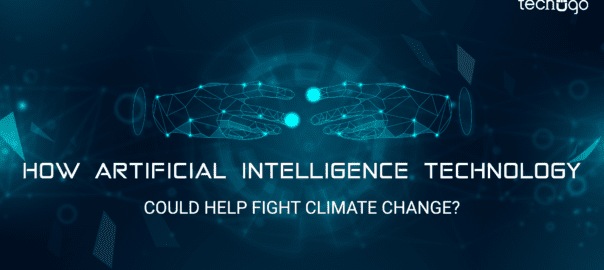24 Jun 2019
How Artificial Intelligence Technology Could Help Fight Climate Change?
Techugo Pvt. Ltd.

Artificial intelligence and machine learning have the capability to lead the world towards its better version. They have the potential to create some inroads against our significant threat; Climate change.
The world is currently struggling to create innovative solutions, to dissolve the climatic threat we are facing. And just in time, some of the biggest and popular names in AI research have exhibited a blueprint. Also, the plan includes suggestions on how the combination of ML and AI can stop the destruction of the planet. This road map can actually save the humanity and the entire planet from imminent jeopardy.
The report includes possible ML interventions in 13 different areas, like forests, farms, climate prediction and electricity systems etc. With in each area, it explains the contributions for different sub-discipline, with the help of ML. Other technologies like reinforcement learning, computer vision and natural language processing are also included.
The recommendations are distributed into three categories:
- High Leverage: This classification is for the problems suitable to ML. In this category, such interventions may have a powerful imprint.
- High Risk: This category is for pursuits that have sure outcomes. Uncertainty is because of the fact that the technology is not mature enough. Another reason is that, not much is known to access the aftereffect.
- Long Term: It is for the solutions that is not going to have any payoffs until two decades.
Many of these recommendations also included the existing efforts that are happening right now, but not at scale.
David Rolnick, a postdoctoral fellow at the University of Pennsylvania, led the report compilation. He was advised by several well known figures;
- The co-founder of Google Brain- Andrew Ng
- The CEO and founder of DeepMind- Jennifer Chayes
- A leading entrepreneur and educator- Demis Hassabis
- The managing director of Microsoft Research- Yoshua Bengio(winner of the Turing Award)
While the researchers provide a very detailed list of a few of the major domains where the ML can help. But this is not a magic wand. The implementation of the policy will be the power-house, for an effective large-scale climate action.
Below mentioned are a few high leverage recommendations, from the report. Have a look.
Find Out New Materials
Researchers and scientists need to create materials that can harvest, store, and use energy more effectively. But the complete process of discovering unknown materials is imprecise and slow.
This is where machine learning can jump into rescue, and accelerate the process. By designing, finding, and evaluating new chemical structures of unknown materials infused with desired properties, the process can get a needed push.
There is a possibility to design solar fuels, that can store energy from sunlight. It can also identify enhanced carbon dioxide absorbents or its structural materials. Therefore, the reason behind this is to create a substitute, that takes a lot less carbon. The final developed material could one day replace cement or steel. The production of which is the reason behind 10% of all greenhouse gas emission.
Reduced Barriers To Electronic Vehicle Adoption
What is the major strategy for decarbonizing transportation? Electric vehicles.
Machine learning and artificial intelligence can help to resolve the adoption challenges for the same. Smart algorithms can ameliorate battery energy management to improve the mileage of each charge. This will help to reduce range anxiety.
For example, it is possible to develop and predict total charging behaviour. This will help grid operators meet and hence, manage the load.
- Create Accurate Estimates On Consumption Of Energy
Many places in the world have almost no data on their greenhouse gas emissions and energy consumption. Hence, it can be a problem when it comes to designing and implementing fruitful mitigation strategies. Computer vision techniques can fetch building characteristics and footprints, from the satellite imagery. So, This is done in order to feed ML algorithms that can predict energy consumption, up to city-level.
The same strategies could also figure out, the buildings that need new parts, in order to maximize the efficiency.
Fabricate Precision Agriculture Possible At Scale
Monoculture is predominant in modern-day agriculture. It is the practice of cultivating a single crop(like wheat, corn, etc), on a large land. This approach makes it easier for farmers to manage the land, with automatic tools or tractors. One of its disadvantages is that it strips the soil of its fertility, and hence reduces its productivity.
Therefore, most of the farmers rely on nitrogen based fertilizers. There fertilizers convert into nitrous oxide, which is a greenhouse gas, and is a lot powerful than carbon dioxide.
Development of robots that run on ML software could assist farmers manage a mixture of crops on a large scale. Algorithms could help farmers to decide;
- What kind of crops to plant(wheat, corn, etc)
- When to plant them
- How to increase the fertility of the land
- How to reduce the use of fertilizers
Enhance Prediction On Electricity Consumption
In order to rely on renewable energy sources, it is necessary to predict the amount of energy required. Algorithms that can predict energy demand, already exists. But further improvements can be made considering household behaviour and climate patterns.
Extra efforts to make algorithms more explainable could help the utility operators. They could interpret the output and decide when to bring the source back.
- Make Buildings More Efficient
Effective and intelligent control system can drastically decrease a building’s energy consumption, by building occupancy and weather forecast. Control system can also regulate other environmental conditions like heating, ventilation, cooling and lighting.
An efficient and smart building could also communicate directly with the gird operators to meet, in order to regulate the use of electricity supply.
- Optimize Supply Chains
ML can optimize the shipping routes. It can also reduce inefficiencies and carbon emissions in the supply chains of the fashion, food and e-commerce.
Better predictions of demand and supply should significantly reduce transportation and production waste. Therefore, targeted recommendations for low-carbon goods could encourage environment-friendly usage.
- Change The Way Of Shopping
Different strategies that advertisers have used to attract consumers could be used to behave in more environmentally aware methods. Therefore, consumers could receive crafted interventions to promote energy saving programs.
CONCLUSION
The amazing combination of machine learning and artificial intelligence has the power to shatter all the boundaries, and create a world free of any imminent climatic peril. Since, technology is the only way to refine the living conditions, it is better to connect with the experts who breath perfection.
Get in touch.
Write Us
sales@techugo.comOr fill this form



 SA
SA  KW
KW  IE
IE AU
AU UAE
UAE UK
UK USA
USA  CA
CA DE
DE  QA
QA ZA
ZA  BH
BH NL
NL  MU
MU FR
FR 













